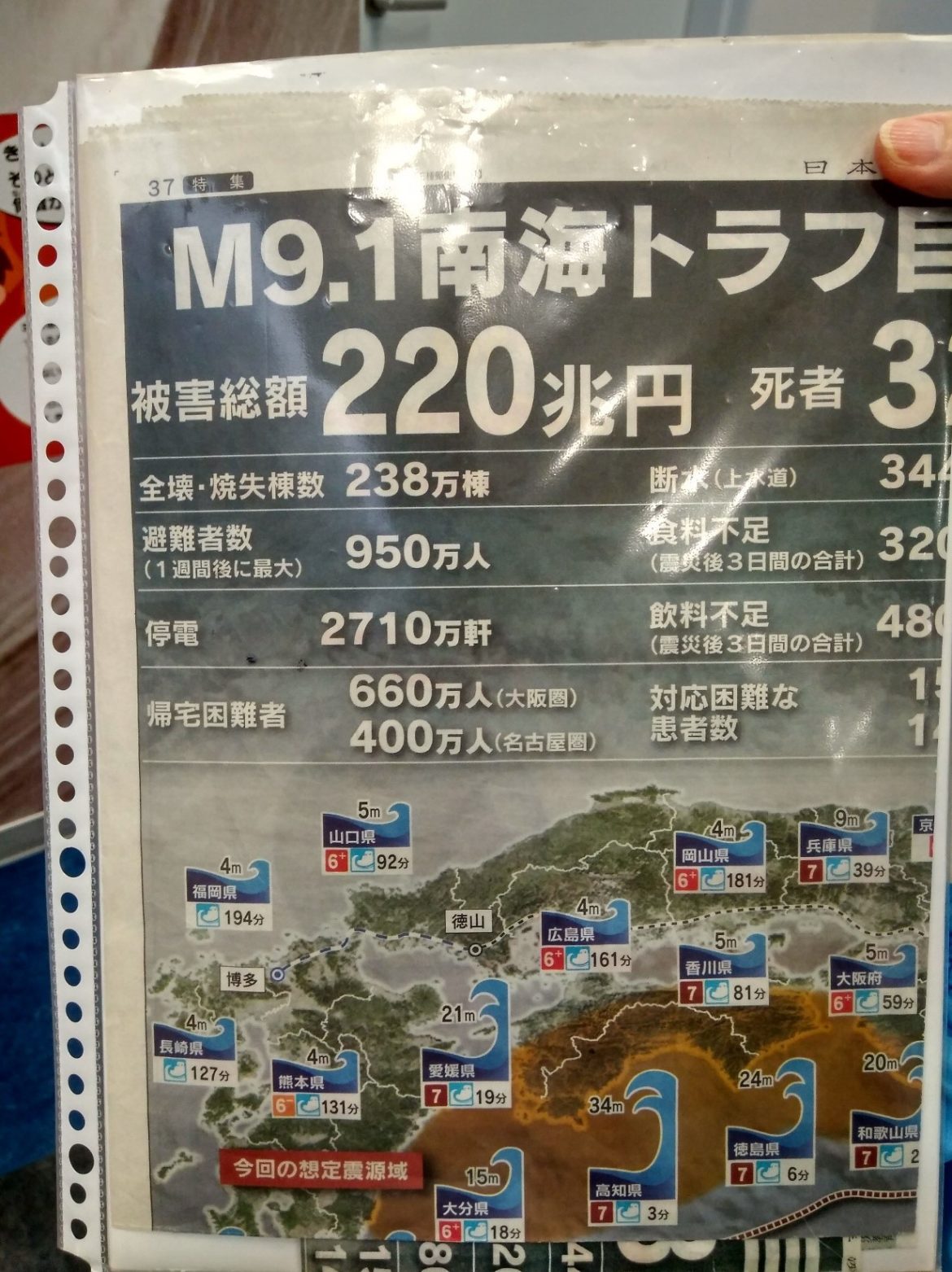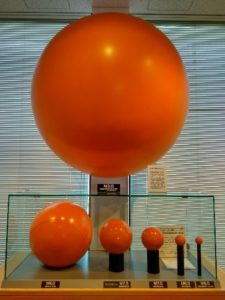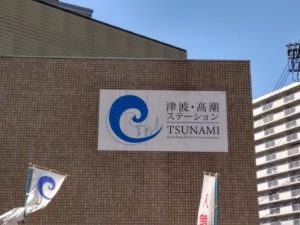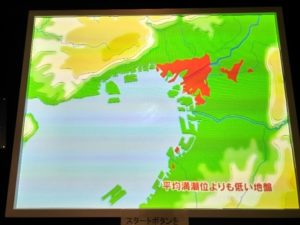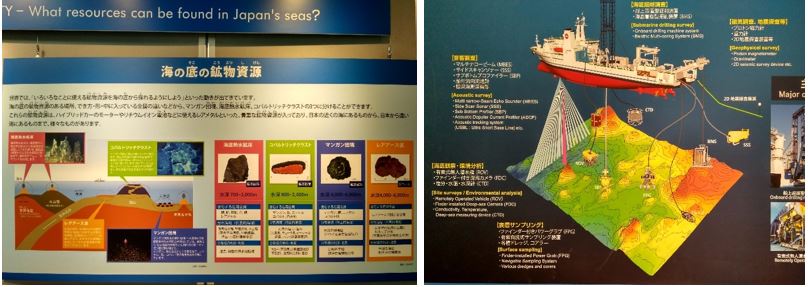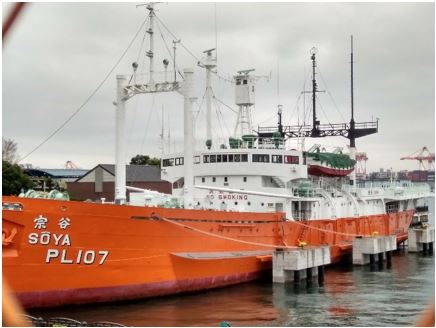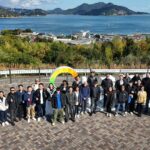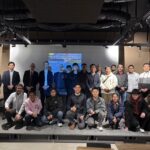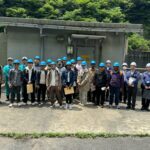1. Internship title:
“Field internship for tsunami and storm surge prevention facilities”
2. Objective:
In this field internship, the student will visit several places regarding tsunami and storm prevention facilities in Osaka and Tokyo port. The knowledge from Kansai University and water/ocean museum hopefully can broaden student’s mind and supported student’s view for his research.
3. Participant
- Name : Mochamad Riam Badriana
- Affiliation : Graduate School for International Development and Cooperation (IDEC),
- Hiroshima University, Japan
4. Schedule Plan
| Date | Activity |
| 13 March 2018 | · Study visit to Kansai University · Visit tsunami and Storm Surge Disaster Prevention Station, Osaka |
| 14 March 2018 | · Observe Osaka’s flood control gates and storm surge prevention structures along: – Aji river gate – Kizu river gate – Shirinashi river gate · Go to Tokyo |
| 15 March 2018 | · Observe flooding control gates and area around Tokyo port |
| 16 March 2018 | · Visit Tokyo Maritime Museum · Visit Water Science Museum |
| 17 March 2018 | · Observe flooding control gates and area around Tokyo port |
| 18 March 2018 | · Back to Hiroshima University |
5. Report
5.1 Study visit to Kansai University
We went to Kansai University and met Dr. Eng. Tomohiro Yasuda as Associate Professor in Coastal Engineering, Department of Civil, Environmental and Applied System Engineering, Faculty of Environmental and Urban Engineering. My supervisor, Assoc. Prof. Han Soo Lee explained tsunami & storm surge modeling. Also, he explained a bit regarding Adaptive Mesh Refinement (AMF) that he is working now in Seamless (tsunami & storm surge) inundation model. The beneficial of AMR is the reduction of computational time with a high accuracy. For further works, AMR or any model related to coastal/ocean will be studied by his students. He hoped to simulate AMR and apply the model in Yasuda-sensei works which is tsunami inundation in Wakayama Prefecture. Yasuda-sensei gave his idea for the feedback and gave us some references not only to a model but for each person thesis research.

Photo of Chess Lab members with Lee-sensei (right) and Yasuda-sensei (second from right) at Kansai University (left picture) and Kansai University logo (right picture)
5.2 Disaster Reduction and Human Renovation Institution (DRI)
Kobe earthquake “The Great Hanshin-Awaji Earthquake” occurred at 5:46 JST of January 17, 1955, with 7.3 magnitude earthquake centered in the northern part of Awaji Island in Hyogo Prefecture. It hammered the nearby metropolitan area that many elderly persons called home and wreaked enormous damage including more than 6,400 dead. The DRI has inherited the experiences and lessons of the Great Hanshin-Awaji Earthquake so that it can disseminate information necessary to prevent and reduce disasters. Visitors acquire accurate knowledge about disasters and their prevention from exhibits, films, and stories told by earthquake survivors.
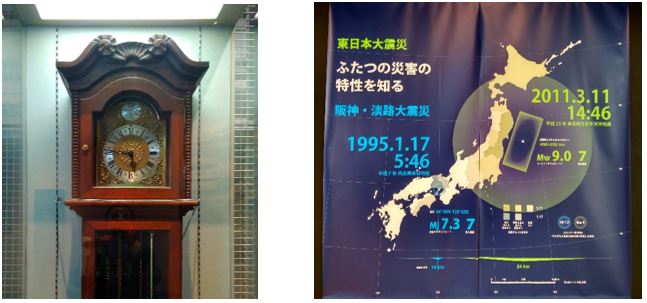
Time showing 5:46 when The Great Hanshin-Awaji Earthquake occurred (left). Comparison between disaster in Kobe and Fukushima which both of them caused tesunami after the earthquake happened (right).
Visitor can imagine the power of the earthquake in 1.17 Theater with their movie “Hit at 5:46” for over 7 minutes. It shows the tremendous destructive power of Kobe earthquake which is portrayed using sound and dramatic images in a room with big screen. After that, visitor will be brought to realistic dioramas reproduce devastated streets just after the Great Hanshin-Awaji earthquake and let watch documenter showing towns, people, and the problems faced during the recovery and reconstruction process after the earthquake up to present day. Other movie was shown in Heart Theater (3D) with titled “Scars of a Tsunami” and theater showing the threat of wind and water disasters documentation.
DRI divides the exhibition into several sections in each floor, for example, Memories Corner, Reconstruction from the Earthquake Corner, Miracle of the Planet of Life, Disaster Protection, and Reduction Workshop, Gallery, etc. In Memorial corner, exhibited earthquake related-material along with stories of those who donated the materials. The real documents are shown in chronological order and by theme. Some videos are comparing the disaster area of then and now. The process of disaster recovery in personal lives and communities, portrayed in dioramas are shown “in the road to recovery” section. Information about earthquake disasters is introduced with computers. People lives and aspects of the towns in the reconstruction process after an earthquake are explained with graphics. Sometimes, they invite and give stories and experiences by the storytellers in person. Not only limited to Kobe earthquake, documentary images of recent natural disaster around the world are shown disaster impact Gallery.
In the Experience Protection and Reduction against Disaster section, they provide magnitude scale and seismic energy, disaster prevention & reduction kit and seismic experience stage. The staff shows structure building behavior due to incoming disaster.
Location:
- Hyogo Earthquake 21st Century Research Institute,
- The Great Hanshin-Awaji Earthquake Memorial,
- Disaster Reduction and Human Renovation Institution
- 1-5-2, Wakinohama Kaigan-dori, Chuo-ku, Kobe City 651-0073
- TEL. 078-262-5050 (exhibition room), TEL. 078-262-5058 (Library)
- URL: http://www.dri.ne.jp/
5.3 Tsunami and Storm Surge Disaster Prevention Station
The Tsunami/Storm Surge Disaster Prevention Station comprises the Disaster Prevention Building and Display Building. The former building provides collective control for tsunami and tidal surge protection facilities, such as seawalls and gates, administered by the Nishi Osaka Flood Control Office. They also provide theater, called DYNACLUB, where dynamic images are displayed seamlessly on the front, right and left sides, even on the floor, the use of sound effects generated by a floor vibro-acoustic speaker further makes visitor feel as if the visitor were caught in real life tsunamis. This facility helps visitor to experience the fear of tsunamis in an overwhelming, dynamic atmosphere.
Osaka is below sea level and often inflicted by tsunami and tidal surge disasters. Areas below sea level are land areas whose surface is lower than average sea level at high tide. At the beginning of Showa period (~1927), a large volume of underground water was pumped up for industrial use, causing serious problems such as subsidence. Nowadays, approximately 40 km2 of areas are below sea level, home to approximately 1.08 million people. Osaka has been hit by typhoon, such as Muroto (1934), Jane (1950), 2nd Muroto (1961) which gave death & injuries to people, and submerged many houses. Then, Osaka builds many protection facilities, in example tidal surge protection gate, tide gate, coastal improvement, super levee, and drainage pump station.
The earth is covered by approximately 10 bedrocks called “plates”. Earthquakes often occur on plate boundaries. In the Nankai through, earthquakes happen when the deformation generated by plate subduction reaches the limit, causing a sudden basement slip. When this happens at the sea bottom, the vibration from the slip is conveyed to the ocean’s surface, generating tsunamis. Japan is surrounded by Eurasia Plate, Pacific Plate, North American Plate and Philippine Sea Plate. It has been identified that giant earthquakes occurred in the Nankai Trough in the past in a 90-to 150-year cycle. It has found that in the three expected epicenter areas (Nankai, Tonankai, and Tokai through) three earthquakes often occur together in a short period of time.
It predicted that Nankai earthquake will happen within 30 years with 50%-60% probability and within 50 years with 80%-90% probability while Tonankai earthquake will occur within 30 years with 60%-70% and within 50 years with more than approximately 90% probability. Tsunamis generated by the Tonankai/Nankai earthquakes will hit Osaka coastal areas in the near future. In 2003, Osaka Prefecture conducted a tsunami simulation on the assumption that the largest-scale Nankai earthquake would occur (examining tsunamis in terms of height, arrival time and current speed). The tsunami heights indicated are expected maximum heights based on the assumption that earthquakes occur at high tide.
Knowledge to protect our life from tsunami disaster is exhibited at the end of the section. They give several points to do before and after evacuation if the disaster occurred. Osaka Prefecture is developing a collective management (remote monitoring, control, motorization, etc.) of tide gates and (iron) tide protection gates for opening/shutting operations. If disaster happens, The Japan Meteorological Agency (JMA) releases Early Warning immediately after the occurrence of an earthquake. Tsunami warning will be given when the potential earthquake is followed by a tsunami. Such information is systematically provided to citizen immediately in variety of ways, such as TV, radio, PC (through the web), loudspeaker car, fax, mobile phone, self-defense force, fire department, etc.
Location:
- Tsunami and Storm Surge Disaster Prevention Station,
- 2-1-64, Enokojima, Nishi-ku, Osaka 550-0006
- TEL. 06-6541-7799
- URL: http://tsunami-osaka.jp
5.4 Museum of Maritime Science
Japan is surrounded by the ocean in all directions and has drawn its strength from the sea since ancient times, developing as a maritime nation that relies heavily on marine resources. It can be said that important role of Japan on the international stage has its foundations in its development of maritime industries such as shipping and ship-building. In the years to come, the oceans will continue to play an important role in Japan’s economic and cultural development as well as its ability to contribute on a global scale. As Japan moves from being a country protected by the sea, to one protects the sea, the museum of maritime science aims to deepen public understanding an awareness of the oceans through a variety of proactive initiatives that highlight the culture of the ships and the sea.
Existed much structure outside the museum, such as large screw propeller, Lighthouse, Battleship Mutsu main gun, superconducting electromagnetic propulsion system, Soya ship, and deep exploration ship. Inside the exhibition annex, visitor can see Japan historical ship, from ancient, warship, and recent navy ship model. Seas of Japan are shown in bathymetry map of Japan and its surrounding. Sometimes they held canoeing and canoe sailing class in training pool beside museum main building.
Antarctic Research SOYA
Soya was built in 1938 as a cargo icebreaker. Following her service during World War II, she was used as a repatriation ship and then a lighthouse supply ship. From November 1956 to April 1962, she made six trips to the Antarctic as Japan’s first Antarctic research ship. Until her retirement in 1978, the Japan Coast Guard used Soya as a patrol ship. Soya has been moored at the Museum of Maritime Science as part of its permanent exhibit since May 1979.
In order to facilitate museum’s renovation, all exhibitions in the main building have been temporarily closed.
Location:
- Museum of Maritime Science
- 3-1 Higashi yashio, Shinagawa, Tokyo 135-8587
- TEL. 03 (5500) 1111
- URL: http://www.funenokagakukan.jp
5.5 Tokyo Water Science Museum
This is a museum which explores wonders of water from a scientific view as well as allowing one to deepen their interest in water and the waterworks in experience style. The museum provides aqua tour and exploration of Ariake Water Supply Station which is an actual functioning facility that shows how water arrives in our home. The museum divides each floor as each section, such as aqua trip, aqua forest, aqua laboratory, aqua town, aqua showcase and aqua park.
Visitor will be brought to the room of Aqua trip on the 3rd floor and watch a film titled “Hear the Song of Water”. The film shows the journey of a waterdrop and traces its journey into ‘Big Cycle of Water’ supported by the projected scenes on four screens (forward, left, right, and ceiling). Aqua forest section outside previous room shows aerial views of the forest as the source of water supply. Some exhibit illustrates certain indispensable tasks carried out by forest in the process of water generation, and the deep relationship between the two. It is introduced Tokyo has pure and high-quality water as a gift of great nature. The vast forest area located around upper Tokyo reaches of Tama River is managed by the Tokyo Bureau of Waterworks as water resource forest.
In the Aqua laboratory, visitor can have amazing experiences with water. The exhibit introduces how through a combination of elements focused on water purification processes and related technology. Three water treatment technologies in particular flocculation, Ozonation Treatment, Biological Activated Carbon Adsorbing Treatment have been adapted into games which provided by museum so the visitor can enjoy and understand the processes of creating tasty water. Five types of experiment concerned with water quality are prepared, such as Bermuda triangle, water vortex, water pressure, Bernoulli, etc. Also, the staff carries out a number of demonstration/experiment which change regularly. Aqua town section explains the role of water in daily lives (kitchen, bathroom, laundry, etc.) through miniature of houses, schools, offices, factories, and other buildings.
Location:
- Tokyo Water Science Museum
- 3-1-8 Ariake Koto-ku, Tokyo
- TEL. 03-3528-2366
- URL: http://www.mizunokagaku.jp
5.6 Flooding Control Gates
Osaka is an alluvial plain with low ground height, formed mostly by the flood of Yodo River and Yamato River. These river gradients are relatively moderate and it is nearly the tide zone up to the foot of Ikoma Mountain. Since it is a low ground, it is often suffering damage from flooding, so many flood control projects have been done since ancient times. Major disaster occurred due to the storm surge caused by the 2nd Muroto typhoon in 1964 when the damage was enormous. As a permanent storm surge countermeasure project, the emergency three-year plan was decided, construction of tidal facility was carried out and completed in 1964. However, in consideration of social, economic situation and ground subsidence, it was necessary to further strengthen the maintenance of tidal facilities. In 1964, the “Osaka Storm Surge Protection Countermeasures Permanent Plan” was drawn up, and a tidal floodgate including three large floodgates was built.
Table 1. Observed Flood Gates Location in Osaka
| Name / Location | Longitude | Latitude |
| Kizu River | 1350 28” 45.75’ E | 340 39” 3.96’ N |
| Shirinashi River | 1350 27” 49.98’ E | 340 39” 30.36’ N |
| Aji River | 1350 27” 22.03’ E | 340 40” 31.70’ N |

Miniature of Flood Gate construction in Aji River (left) and the arch-shaped flood gate with red color indicates when the water gate is closed (right) (http://www.pref.osaka.lg.jp/nishiosaka/emergency/high-tide.html).

Illustration of Flood Gate protect city from high tidal and high wind waves. When Flooding Gates prevent the incoming waves, the water from river will be diverted to Yodo River (http://www.pref.osaka.lg.jp/nishiosaka/emergency/high-tide.html).
Tokyo Port which located deep within Tokyo Bay is highly isolated to the southwest and has very shallow waters. This port is highly susceptible to the effects of high tide and rising water levels are considered as high waters. Tokyo Port shoreline protection facilities have been developed since 1961, such as outer levees, flood gate, and drainage pumping sites designed to protect land from high tides. During the Great Tohoku Earthquake which occurred on March 11, 2011, the closing of floodgates worked to prevent damage from the tsunami. Floodgates and pump stations have been built in the early 1960s through the middle 1970s. Flood Control Gates in Tokyo bay are divided into several area: Koto district, Morning tide area, Tsukiji district, Konan district, and Shikugawa area. Tokyo Waterfront City.
Table 2. Observed Flood Gates Location in Tokyo
| Name / Location | Longitude | Latitude |
| 1 | 1390 50’ 8.59” E | 350 39’ 7.94” N |
| 2 | 1390 49’ 18.04” E | 350 38’ 49.09” N |
| 3 | 1390 48’ 28.33” E | 350 38’ 44.51” N |
| 4 | 1390 47’ 54.83” E | 350 38’ 55.47” N |
| 5 | 1390 47’ 14.45” E | 350 39’ 44.82” N |
| 6 | 1390 46’ 3.38” E | 350 39’ 30.96” N |
| 7 | 1390 45’ 50.87” E | 350 39’ 23.38” N |
| 8 | 1390 45’ 31.4” E | 350 39’ 5.48” N |
| 9 | 1390 45’ 28.88” E | 350 38’ 45.92” N |
| 10 | 1390 45’ 7.55” E | 350 38’ 6.63” N |
| 11 | 1390 44’ 57.37” E | 350 37’ 27.81” N |
| 12 | 1390 44’ 53.82” E | 350 37’ 7.96” N |
| 13 | 1390 48’ 31.1” E | 350 39’ 54.44” N |
| 14 | 1390 48’ 8.82” E | 350 39’ 54.28” N |
| 15 | 1390 47’ 38.02” E | 350 39’ 47.74” N |
| 16 | 1390 46’ 32.3” E | 350 39’ 16.26” N |
| 17 | 1390 46’ 20.44” E | 350 39’ 31.12” N |
| 18 | 1390 46’ 37.14” E | 350 39’ 43.75” N |
| 19 | 1390 45’ 5.65” E | 350 33’ 23.8” N |
| 20 | 1390 45’ 0.4” E | 350 33’ 31.19” N |
| 21 | 1390 44’ 46.26” E | 350 34’ 8.65” N |
| 22 | 1390 44’ 37.41” E | 350 34’ 15.77” N |
| 23 | 1390 44’ 24” E | 350 34’ 29.12” N |
The flood gate is installed at the boundary between outer waters divided by outer levee and the inner waters. When the water rises due to storm surge, it will close the gate and prevent the rise of water level in the inner watershed. Three kind of flood gates are installed in Port, roller gate, swing gate, and sector gate.
6. Conclusion
The student had visited several Flood Gates and museums related to ocean. The obtained knowledge from field internship made the student realize more that coastal structures are necessary, not only protecting city and people behind them but also sign of development city in utilize marine sector for shipping and economic field. It was stated, Japan will face many natural disasters in future, particularly earthquake and tsunami caused by Nankai through. Thus, this internship encourages more the student to deepen his knowledge and apply in coastal field.
The Original Internship Report
